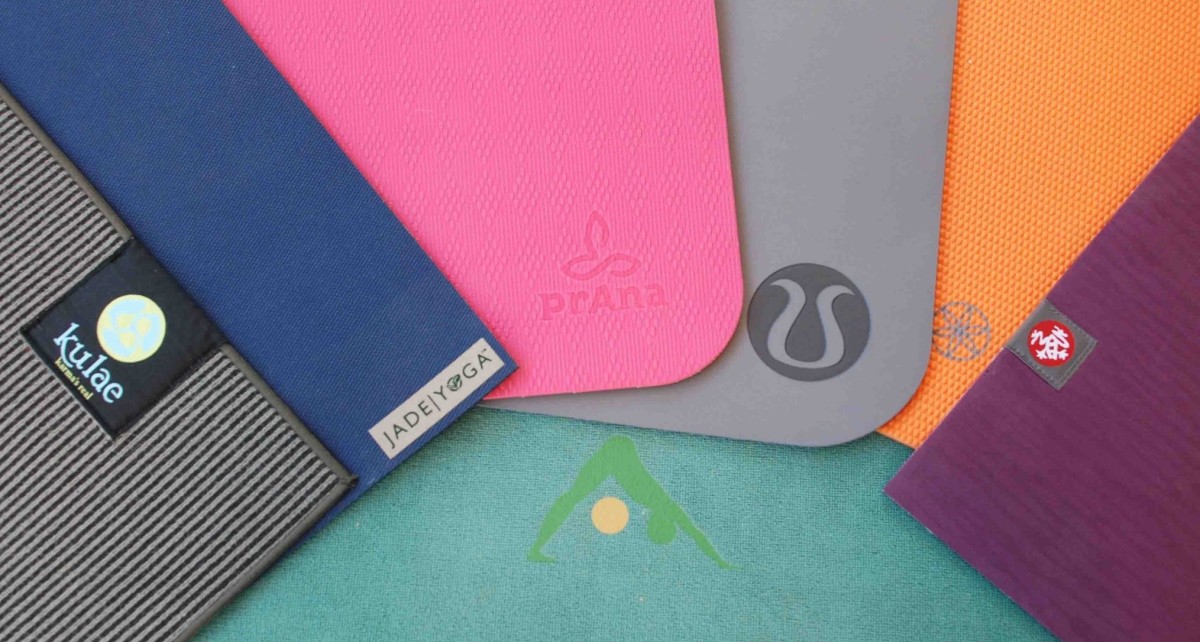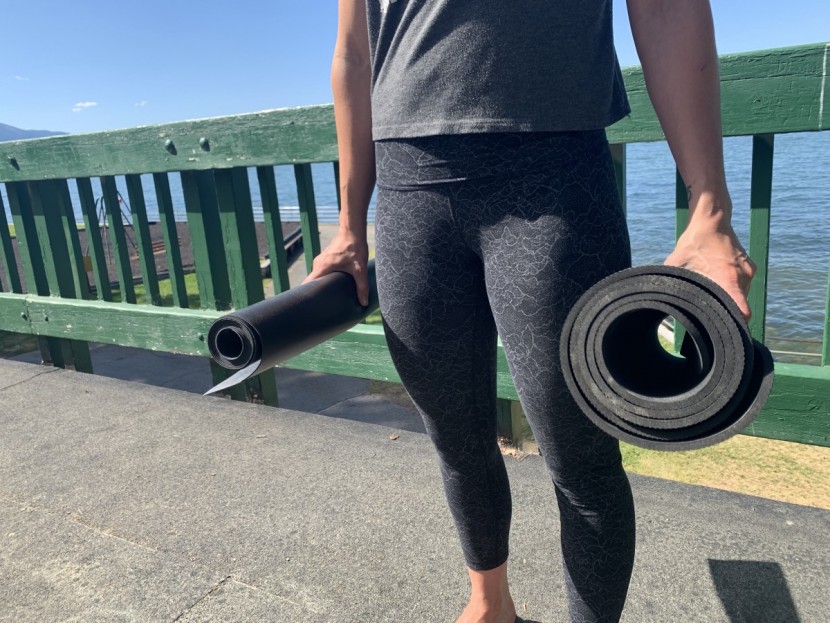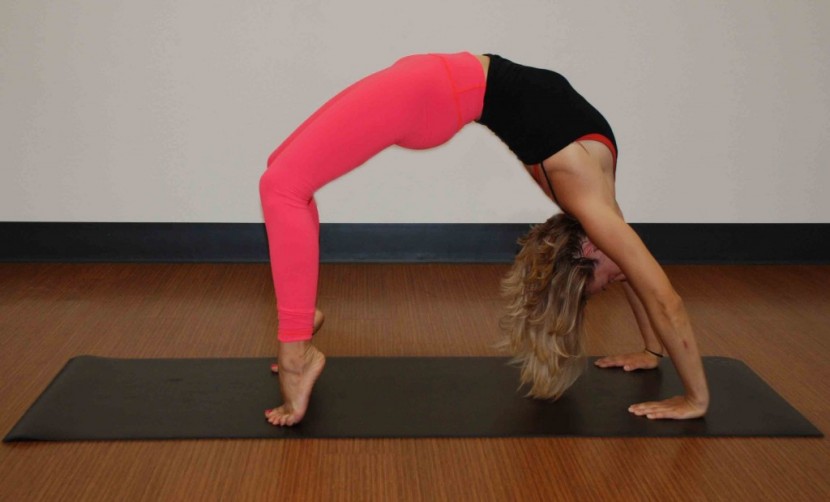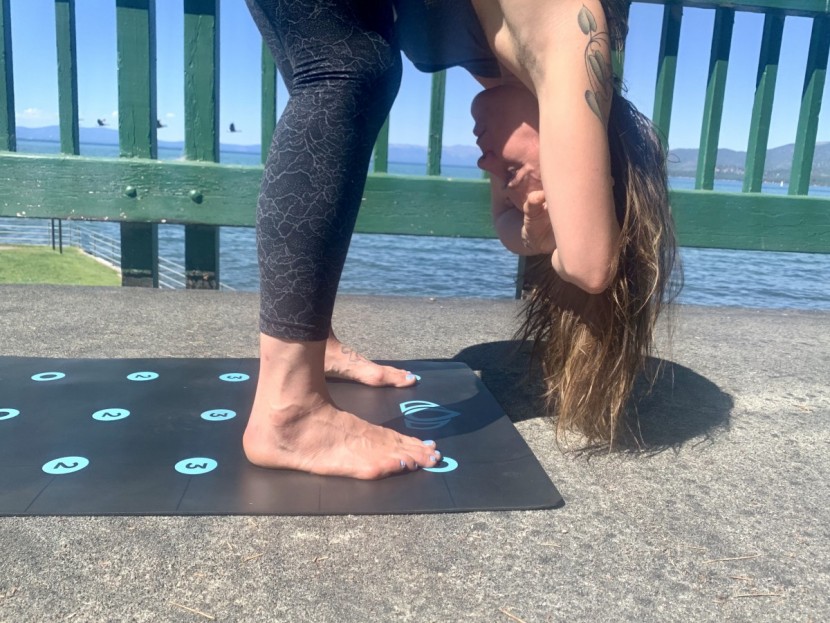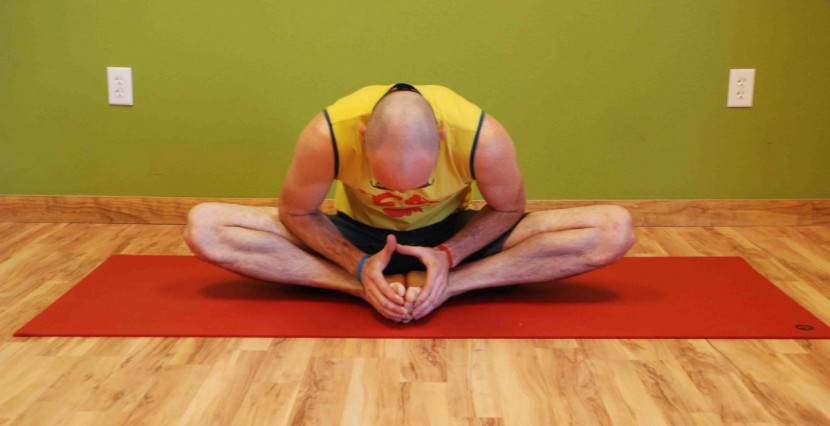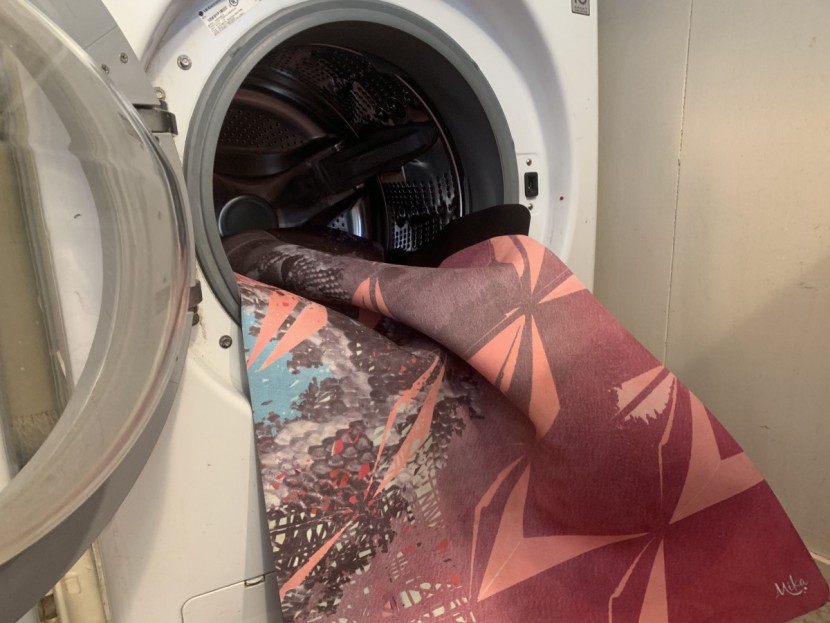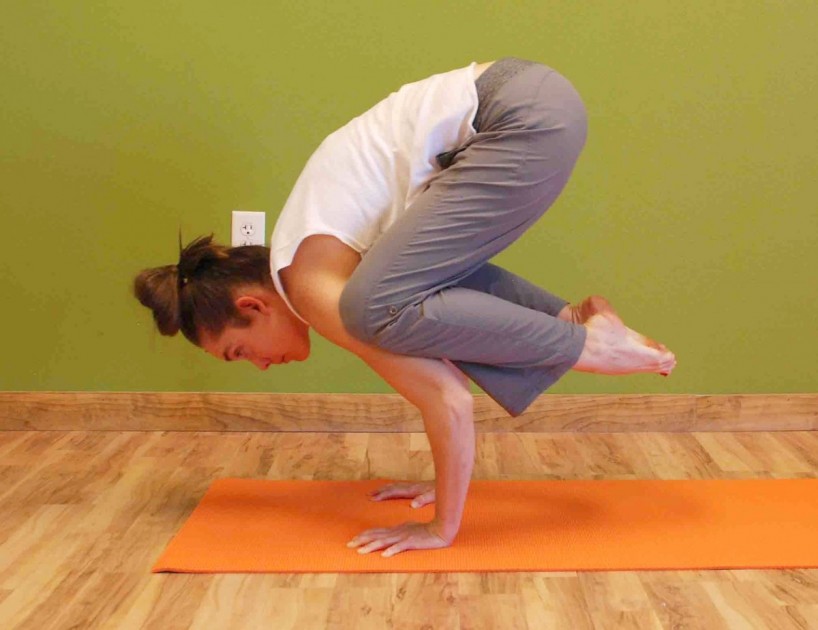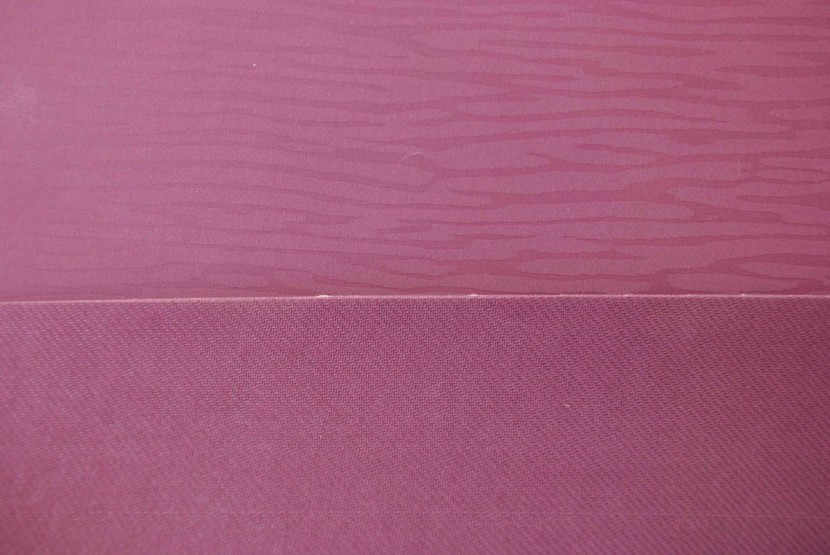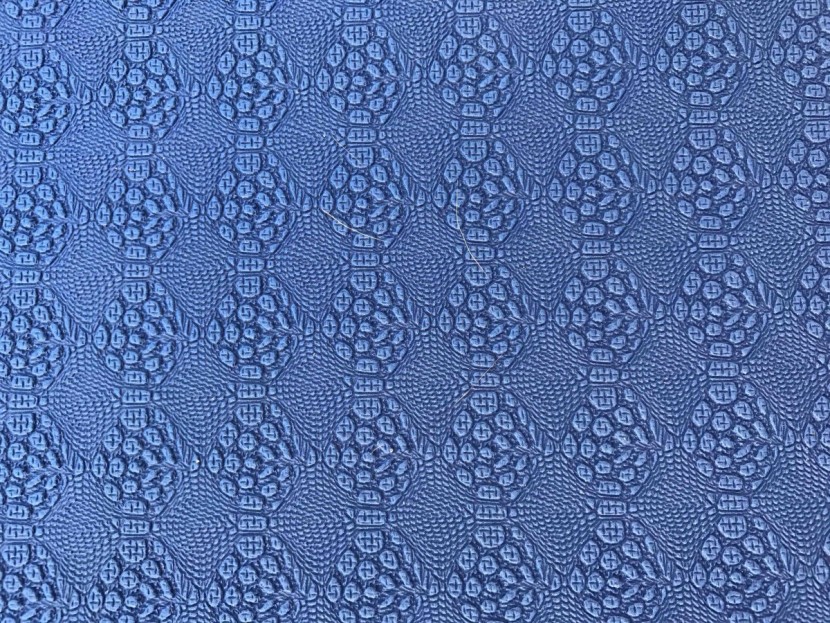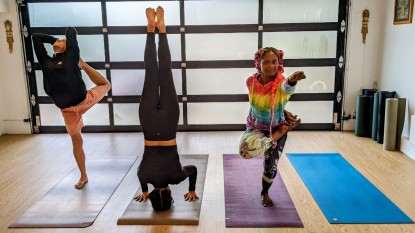Runners have many options for running shoes (minimalist, barefoot, trail, street, pronation correctors, etc.), as do yogis with their mats. The number of mats and different types now available is staggering and can lead to confusion. We hope to cut through the hype to give you the essential information you need and to help you buy the best yoga mat, no matter what style you practice. Our goal is to cover the best options for your practice, review the different materials used, weigh in on the importance of portability vs. comfort & stability, and give tips for keeping it clean.
Thickness
The thickness of your mat is a key consideration; this is where specifically designated “yoga” mats get separated from other types of mats used in gyms for ab work or Pilates classes. Yoga mats are typically between three and five millimeters thick (or 1/8 to 3/16 inches), with some thinner one to two-millimeter “travel mat” options thrown in the mix. There is a particular reason for this thickness; in most styles of yoga, except for Restorative or Yin classes, a large portion of the class is spent in standing postures. When standing on a top-ranked yoga mat, you need some cushioning for your joints, but too much cushion is detrimental to your balance; try standing on one leg on top of your bed, and you'll see what we mean. You also want cushioning for your class's seated and lying down portions.
Your entire body is much happier when properly cushioned from hardwood or cement floors when on the ground. Mats of four to five millimeters are the most popular thickness used, as this strikes the perfect balance for most people. Some people require or prefer extra cushioning, and there are a few yoga-specific thicker mats out which provide joint support but not too “squishy.” Want more cushion? Layer two mats on top of each other or fold your mat over during poses on your knees. Most yoga studios also offer blankets that you can use under your knees if you decide to opt for a thin mat.
Those who prefer a thinner mat can opt for a three-millimeter version, but most brands manufacture a one to two-millimeter travel mat that rolls up tightly and/or folds up to fit in your suitcase or duffel bag. If you want zero cushioning, go for one of these. These mats also tend to be less expensive than thick ones because there is not as much material involved. Therefore, this may be a good option if you want to save money and still have something high-quality.
Thick and squishy mats are similar to the mats you see in many gyms for stretching or doing ab work. While they offer great cushion for your back, they are challenging to do yoga on and often do not last very long.
Style Practiced
More than anything, the style of yoga you practice determines your mat needs. With the different kinds of yoga classes expanding and specializing, so are the mats on the market. While that doesn't mean you can't use the same yoga mat for many different styles, we think you'll be happier if you pick one that suits your practice and body type. For example, if you don't have a lot of “natural” cushioning and purchase a thin yoga mat and use it on a wood floor, some poses may be painful.
Conversely, if you purchase an extra-thick mat but have a practice that involves frequently balancing on one leg, or use yoga blocks often, you'll have a harder time in those poses. Here are some recommendations for which mats go with which styles. However, if you do like a variety of yoga, you'll be able to find something that lands in the middle.
Basic Classes (Level 1)
If you are new to yoga or prefer a calmer and gentler practice, you don't need to go all-in with a $100 yoga mat, but you will want something with good traction, comfort, and stability. If you aren't sure if this practice is for you, then it makes sense to purchase a less expensive mat or rent a mat from the studio. Look first for a model that offers a good amount of traction, and if you are willing to spend the extra money, something that offers some cushion is also important.
Flow/Vinyasa Styles
These classes are more rigorous than a basic class. Usually, involving multiple Sun Salutations and vinyasas, you are constantly moving on the mat. This style works best with a yoga mat with great traction, as the pose you'll hold most often is Downward Facing Dog, which requires you to push in opposite directions with your hands and feet. If your mat is slippery, you'll constantly be readjusting your hands, which certainly isn't ideal. There's also the potential for your hands to slip, and you may hurt yourself. Since you'll be working hard, your internal temperature will also heat up and cause your palms to sweat, potentially impeding your traction; we recommend looking for a mat with great dry and wet traction.
Restorative or Yin Classes
Restorative classes do not involve the active engagement of your muscles. Instead, they use the force of gravity and time to bring about deep releases in your muscles and fascia (connective tissue). These classes take place primarily in seated postures or even lying on the ground- affectionately referred to as "nap yoga"- so for this style, you'll want a plush and comfortable yoga mat that is at least five millimeters thick or even thicker. But again, most studios (especially Yin studios) offer blankets to provide extra cushion. If you practice mixed styles of yoga, we suggest prioritizing traction and stability over thickness.
Heated Classes
Bikram, Moksha, TruFusion, Hot 103, the list goes on. If you practice any of these styles (or something similar), then you are going to sweat sweat sweat during your class. Most people use a towel on their yoga mat to soak up the sweat. You'll want to pick a mat with a “closed-cell” construction, which prevents sweat from absorbing into the mat. Stale sweat can make your mat “funky” no matter how often you clean it. Another important consideration for Hot Yoga or heavy sweaters is excellent wet traction.
Using a towel on top of your yoga mat gives you the option to use the mat by itself for different styles of classes. But if you are a die-hard Hot Yogi, then there are some great towel/mat hybrids out there that will blow your mind. Some options on the market are microfiber towels bonded over a PER (Polymer Environmental Resin) bottom. The whole thing goes in the wash as you see fit and comes out smelling fresh each time, saving you the hassle of trying to rinse off your mat in the shower or putting your face on a stinky mat.
Materials Used
Of all the different industries out there, many yoga mat manufacturers seem dedicated to providing a “green” product, whether it's by ensuring that the manufacturing process is least toxic, by using only “natural” materials in their products, or even planting a tree for every mat that they make. While these are exceptional practices, you should be aware of the marketing trend called “greenwashing”, when a product is marketed for its eco properties when it might not be very “green”. While we cannot deeply investigate every manufacturer's materials and processes, we discuss different materials used and how they're marketed. In the end, buying once should be the primary goal as not to waste material.
Polyvinyl Chloride (PVC)
The original and most common type of material used in yoga mats is P.V.C. It's a hydrocarbon product, aka plastic, and when turned into a yoga mat, the production usually involves the addition of phthalates to keep the plastic malleable and supple. P.V.C. is a known carcinogen and is impossible to recycle because it contains too many toxins. Phthalates are endocrine disrupters and have banned from children's toys. Phthalates “off-gas” from the materials they are in, particularly when heated and can be inhaled in dust particles or absorbed through the skin. These are not the kind of materials you want to be lying and sweating on. The more we learn about the negative side of P.V.C., the less we want to use one. Note that a P.V.C. mat may be the best option for people with latex allergies due to the presence of natural latex found in rubber mats.
Rubber
A great alternative to P.V.C. has been rubber mats. These mats come from rubber harvested from the Pará rubber tree (Hevea brasiliensis). Thin slices are cut from the bark of the tree, create a milky latex that runs out and collected in buckets. After, this liquid is refined into rubber. While some rubber mats are marketed as 99% latex-free, this might not be enough for someone with a sensitivity to latex, and they should avoid rubber mats. Rubber harvesting occurs in tropical and sub-tropical climates in Southeast Asia and Brazil; this is a renewable resource as a rubber tree can be “harvested” for up to 30 years. However, when the pristine rainforest is cut down to make way for a monoculture of rubber trees, it has profound effects on the ecosystem. For this reason, some manufacturers have committed to using only non-Amazonian rubber in their rubber mats. Be wary of the companies that do not disclose where their recycled material comes from.
Thermoplastic Elastomer (TPE)
TPEs are materials that have both “plastic” and “elastic” properties. They are polyester, polyurethane, or polystyrene compounds that can be injection molded, and are in a wide range of products, from snowmobile tracks to medical catheters. TPE mats can be completely recycled and remade into new mats or flip flops if you know where to send your old mat. Some mats have to be sent back to the company in order to be recycled.
Polymer Environmental Resin (PER)
PER is made from P.V.C. but without the phthalates and harmful toxins and emissions required to turn P.V.C. into a yoga mat. It is also recyclable and releases less toxic emissions than P.V.C. if incinerated. It does seem a little strange that they make this “environmentally-friendly” product from something that is not so “green,” but we'll take the scientist's word on this one.
Cotton
After reading about all the above options, cotton rugs are looking more and more appealing! Cotton is a biodegradable and renewable resource, and the organic variety does not contain any harmful chemicals or contribute much to water pollution. However, cotton and particularly conventional cotton does have an environmental impact. Such as high water use, water pollution from insecticides and defoliants, and using land that could otherwise use for producing food. Also, the dying process involves high water use, and even “natural dyes” use toxic mordants. Unfortunately, cotton mats don't provide the same benefits as sticky mats, such as traction and comfort, and aren't likely to replace them any time soon.
Yoga mat manufacturers know that their customers tend to be “eco-conscious” and want to purchase environmentally friendly products. Sometimes you have to wade through the hype to figure out what is what.
Cork
Cork mats are a relatively new fad that has taken off in the past year. They are an exceptional, sustainable option in which cork is a self-cleaning agent, which ensures ease of caring for your new purchase. Cork is a biodegradable material and is easy to dispose of when the time comes. Some companies construct the mat out of cork flakes which can easily come off if your practice is too rigorous.
Portability vs Comfort & Stability
One of the big trade-offs in purchasing a yoga mat is whether you choose one that is portable, or comfortable and stable. Unfortunately, few options deliver both. Most mats that received a high score for portability did not score well in comfort & stability, and vice versa, as heavier mats are more stable and usually thicker and, therefore, more comfortable. Lighter mats are more accessible to tote around.
While some might be comfortable lying on, if they lack stability, then they tend to move on you while doing postures like jumping from Downward Facing Dog to standing. Practicing on a stable yoga mat is essential from a safety perspective; we wouldn't want our mat shifting underneath us while trying to pike up into headstand. Comfortable mats not only give you excellent support during Savasana, but they also protect your joints and bones during many other poses.
For those of us who drive to our studio or practice at home, carrying a six or seven-pound mat from our car to class isn't a dealbreaker. You'll also want to consider the weight of your mat if you practice Hot Yoga and take a towel, shower towel, change of clothes, and toiletries to your studio. Sometimes our yoga bag feels like we are going on a month-long expedition instead of a 90-minute class! Saving a pound or three on your mat helps lighten the load.
Caring for Your Mat
With people's busy schedules and hectic lives, some of us barely have time to make it to a yoga class, let alone take the time to deep clean our mats afterward. While it's probably not high on your maintenance list, a little care for your mat goes a long way. A quick wipe with a damp cloth after every class is a good start, and here are some other tips and recommendations based on the type of mat you buy.
Rubber - Since these mats have an “open-cell” structure, they occasionally need a deeper cleaning than a simple wipe down with water. These types absorb the sweat and oils from your body, so the frequency of deep cleans depends on how much you use it and how much you sweat. With a regular three day a week practice, performing a monthly deep clean should keep it in good shape. Deep clean options include soaking it in a bathtub or hosing it off in the shower or backyard. For cleaning agents, mild soaps or vinegar are good options. Rubber mats should be hung or laid flat to dry but never in direct sunlight, as this causes the rubber to break down.
P.V.C. and TPE - These mats don't need as often a deep clean as a rubber one due to their “closed-cell” structure. However, this type of mat can still get “funky fresh” if not taken care of properly, particularly if used for hot yoga, where it regularly gets drenched in sweat. If you roll your mat up straight after class and leave in a closet until the next time you use it without a rinse or wipe down, it will soon become a stinky distraction. Some companies recommend wiping down their particular mat and never spraying it with a hose or in the shower or soaking it in the tub or washing machine. The best cleaning option with some mats is to use water or mild soap spray, or water and essential oil blend to “freshen” it up a bit. Some materials can dry in the sun (check recommendations for mats by the company), but be careful how you hang them, particularly the TPE mats. TPE mats tend to take on the shape of how they are stored, and it can be hard to get them to lay completely flat. If they are dried hanging over a bar, you might be left with a permanent crease or fold down the middle.
Hybrids -A towel/mat hybrid that you throw in the wash each time? No more struggling with a mat in the shower or tub? It's genius! Just remember to set your washer on gentle (and a front loader without an agitator will make the mat last longer) and hang it up to dry afterward. We've washed some models dozens and dozens of times and they are still looking (and smelling) great.

